

France bans super-skinny models and threatens employers with fines and jail in anorexia crackdown. Updated France's lower house of parliament has passed a law that bans the use of excessively thin fashion models and imposes possible jail sentences on companies that hire them.

The move by France, with its fashion and luxury industries worth tens of billions of euros, comes after a similar ban by Israel in 2013, while other countries, like Italy and Spain, rely on voluntary codes of conduct to protect models. It is part of a wider move against anorexia in France by president Francois Hollande's government, where up to 40,000 people — mostly girls and women — suffer from the condition. The law bans the use of any model whose Body Mass Index (BMI) is lower than levels approved by health authorities. "The activity of model is banned for any person whose Body Mass Index (BMI) is lower than levels proposed by health authorities and decreed by the ministers of health and labour," the legislation said.
Let's Talk About Thin Privilege. I am five-foot-four, 125 pounds.
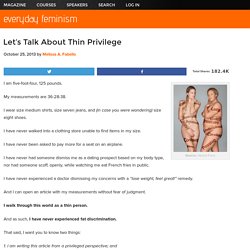
My measurements are 36-28-38. I wear size medium shirts, size seven jeans, and (in case you were wondering) size eight shoes. I have never walked into a clothing store unable to find items in my size. I have never been asked to pay more for a seat on an airplane. I have never had someone dismiss me as a dating prospect based on my body type, nor had someone scoff, openly, while watching me eat French fries in public.
I have never experienced a doctor dismissing my concerns with a “lose weight, feel great!” Plus-Size Dress Form — Size 24 Mannequin Cornell. Plus-size women account for 33% of the American population and 28% of the purchasing power, but there's no denying: a lot is lacking when it comes to plus-size clothing.
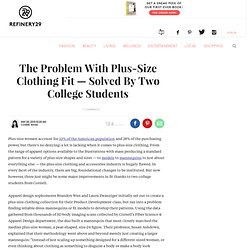
From the range of apparel options available to the frustrations with mass producing a standard pattern for a variety of plus-size shapes and sizes — to models to mannequins to just about everything else — the plus-size clothing and accessories industry is hugely flawed. In every facet of the industry, there are big, foundational changes to be instituted. Why Photoshop is More Deadly Than You Thought. Here at HelloGiggles, we don’t take Photoshopping lightly.
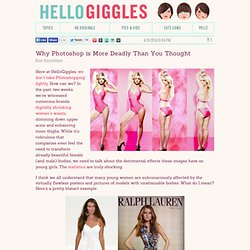
How can we? In the past two weeks, we’ve witnessed numerous brands digitally shrinking women’s waists, slimming down upper arms and enhancing inner thighs. While it’s ridiculous that companies even feel the need to transform already beautiful female (and male) bodies, we need to talk about the detrimental effects these images have on young girls. The statistics are truly shocking.
I think we all understand that many young women are subconsciously affected by the virtually flawless posters and pictures of models with unattainable bodies. This model is naturally a size eight, a perfectly healthy size. Portfolio — Wolf Form CO. INC. USA dress forms NJ/NYC. Wolf Form Vintage Era Dress Forms 1911-1973 Wolf Form Vintage Model Year 1911 Dress Form.
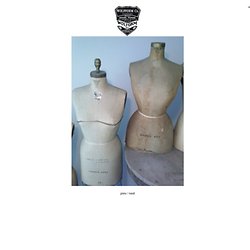
Wolf Form Vintage Dress Forms 1951 and 1911. Wolf Standard Table Model Head Form with cast iron base. Wolf Form Standard Adult and Child Table Model Heads with cast iron bases. Wolf Form Brand Stenciling, Shield and Gold Finial. 18 Empowering Illustrations to Remind Everyone Who's Really in Charge of Women's Bodies. Image Credit: Carol Rossetti.
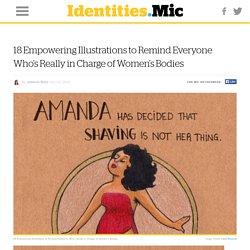
What the Perfect Female Body Looks Like — When You Ask Men vs. Women. They say beauty is in the eye of the beholder – and according to a new survey, it looks like men and women are very different beholders indeed.
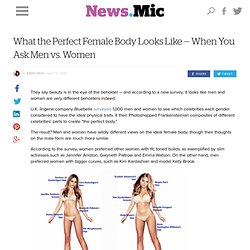
U.K. lingerie company Bluebella surveyed 1,000 men and women to see which celebrities each gender considered to have the ideal physical traits. It then Photoshopped Frankensteinian composites of different celebrities' parts to create "the perfect body. " The result? Men and women have wildly different views on the ideal female body, though their thoughts on the male form are much more similar. According to the survey, women preferred other women with fit, toned builds, as exemplified by slim actresses such as Jennifer Aniston, Gwyneth Paltrow and Emma Watson. Image Credit: Gizmodo. 'Stop The Beauty Madness' Brands Ads With Brutally Honest Messages.
It's a psychological itch that the most enlightened, successful and even beautiful women still tend to scratch: if I look better, I am better.
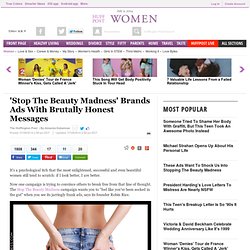
Now one campaign is trying to convince others to break free from that line of thought. The Stop The Beauty Madness campaign wants you to "feel like you've been socked in the gut" when you see its jarringly frank ads, says its founder Robin Rice. Stop The Beauty Madness is a series of 25 advertisements branded with honest messages that highlight the true "madness" involved in creating and meeting beauty standards. Rice, an author and the founder of Be Who You Are Productions, started the campaign to challenge an internalized belief that a woman's beauty determines her value. Rather than attempt to fit more diverse types of women into an already narrow definition of beauty, Stop The Beauty Madness questions the value we place on beauty in the first place.
Vintage Weight Gain Ads Discourage Skinny Bodies (PHOTOS)